#team: lunisolar
Explore tagged Tumblr posts
Text
MOGAI Teamup Archive!
[pt: mogai teamup archive. /end pt.]
Welcome to the archive blog for @rwuffles & @vampitsm's event MOGAI Teamup! This archive is run by @flutteringwings-coining!
Event Info (link) / Prompt List (link) / Teams (link) !
MOGAI Teamup Masterlist [link] - organized alphabetically!
Tags We Use:
#team: [xyz] -> the name of the team #type: [xyz] -> gender, orientation, etc. - term is just for general or unspecified. #prompt: [xyz] -> the prompt from the event #term: [xyz] -> the name of the term #term -> the name of the term, again
#pinned post#mogai teamup#not an archived post#team tags ->#team: the slurrrrrrrs#team: paws and claws#team: THE SWARM#team: amongai#team: kyghtmare 🐾🗝️#team: the mogaierrrrrs#team: orientation hater duo#team: digipet duo#team: mogai mitlas#team: camp liminal#team: mystical mysteries !#team: kiteon#team: lunisolar#team: shark bomb!#type tags ->#type: term#type: orientation#type: umbrella term#type: presentation#type: gender#type: gender umbrella#type: gender system#type: x4x#prompt tags ->#prompt: haunted#prompt: weapon
3 notes
·
View notes
Text
Weekly Tag Wednesday
hi team, i'm behind on these past two weeks' WTWs bc idk how to answer holiday-related questions when i don't rly celebrate any... but yolo
tagged by @energievie, @mybrainismelted, @deedala, and @gallapiech
do you like cooking and/or baking? i like buying ingredients and learning how to make a new dish but i'll get frustrated when it doesn't go right lol
what is your favorite dish to make at home? just dumplings (store-brought)
is there a seasonal (whatever season it is for you right now) food that you often make this type of year? i mean i just help out and we rarely eat it, but wonton when it's close to cny?
is there a particular drink you like during this season? just warm water thanks
are there any regional dishes that are popular in your area this time of year? if so is it a 👍 or 👎 for you? i love zongzi and tangyuan (they need to have only pork tho)
---
what holiday do you and/or your family celebrate at this time of year? the only holiday that we kinda celebrate is cny, but that's still a month left to go
does your family get together to celebrate? my intermediate family yes, i was just asking my dad the other day why we never visit other family members and he said bc they live on the other side of the country/world 😔
are there any traditional foods for the holiday? see above, but also apples, oranges, fried tofu, fish balls, wonton, noodles, and rice cakes?
do you typically decorate for your holiday? my dad puts up some couplets, including the inverted door ones, and those ornaments with tassels
tell me about your favorite holiday memory: ngl it has to be playing jackbox with this discord server cause i was dying laughing (as you can tell my family doesn't rly celebrate holidays)
what is the significance of the holiday you're celebrating? celebrating the new year on the lunisolar calendar (ngl i don't rly know the difference between that and the lunar calendar)
if there was one thing you could change about this holiday, what would it be? actually celebrating it properly with tons of ppl but idk if i actually want that or i just want to feel festive/fit in
anything else you want to tell me about your holiday? idk
not tagging anyone cause i'm so late LOL
8 notes
·
View notes
Text
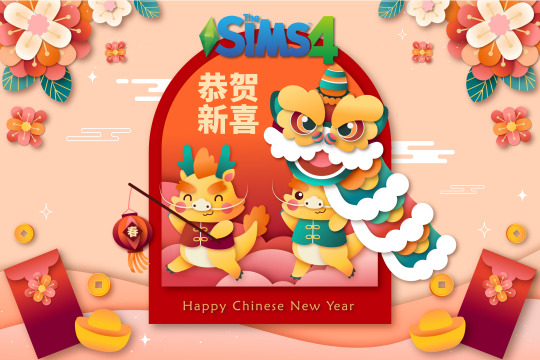
^ Ignore the incorrect grammar on the graphic above, it supposedly says
恭賀新禧 (Gōnghè xīnxǐ) = Best Wishes for Happy New Year

Lunar New Year Update 2019
Lunar New Year Update 2022
✨ There will be upcoming Chinese New Year held on 10 February 2024, which is Year of Wood Dragon. ✨
Recently I opened The Sims 4 game again on Steam --- Yes The Sims 4 Base game is free of purchase on Steam --- Finally I can see soothing and relieving representation of Chinese culture in-game unlike sore eyes disaster what The Sims 3 team had done on Shang Simla for The Sims 3.
Definitely there's something positive on this representation of Lunar New Year updates for 2019 and 2022 that I can give applause to EA👏 , that this company team finally made consultation to actual Chinese (and Korean) people.
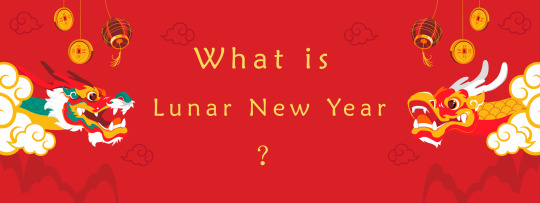
Lunar New Year is a celebration of the arrival of spring and the beginning of a new year on the lunisolar calendar. It is the most important holiday in China, and it is also widely celebrated in South Korea, Vietnam, and countries with a significant overseas Chinese population.
Commonly known as the Spring Festival in China, Lunar New Year is a fifteen-day celebration marked by many traditions.
Not just celebrated in China, Korea and Vietnam celebrate Lunar New Year. So yes, we celebrate New Year twice, Gregorian New Year (1 January) and Lunar New Year (10 February, China Year 2575) in 2024.
I can only review about the Chinese New Year stuff part. I can recognize easily there's steamed fish, noodles, and Nian Gao (年糕) . And the most important part of Chinese New Year is....
🧧 Red Envelope (紅包)🧧
🧧 Hóng Bāo in Mandarin Chinese language.
🧧 Ang Pao in Hokkien Chinese language.
Who doesn't love money? You Westerners like money, don't you? On Christmas Day, Westerners have tradition to give wrapped present gift to people.
In Chinese New Year, we're Chinese people have tradition of giving Red Envelope with money inside the envelope. The person who give Hong Bao at Chinese New Year event is from married person to unmarried family members.
Wrapping lucky money in red envelopes is expected to bestow more happiness and blessings on the receivers.

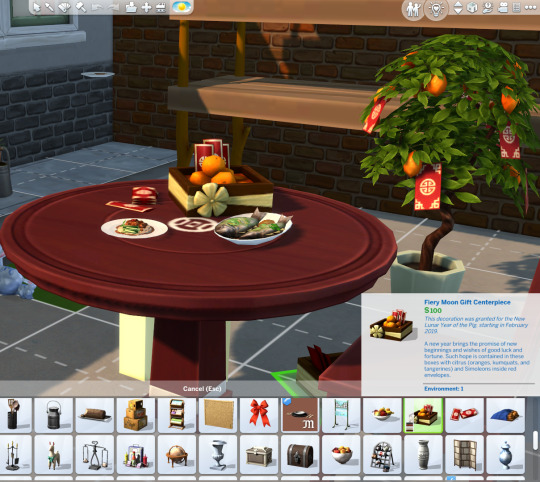
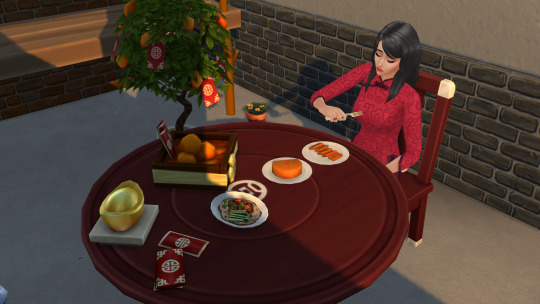
There's addition of Round Table, Red Envelopes on Kumquat Tree and Orange fruit with Red Envelope on box. Yes Chinese culture is all about being prosperous and giving money gift in Red Envelope. I can tell you the representation is very good and authentic to us Chinese people that we can relate.


I can tell you team who worked in this update made consultation to Chinese people, that there are Han Zi (Chinese writing). 無魚不成席 which translates as "No Feast Without Fish" . Fish makes important meal in Chinese dining.

Here is more addition info:
Fish — an Increase in Prosperity
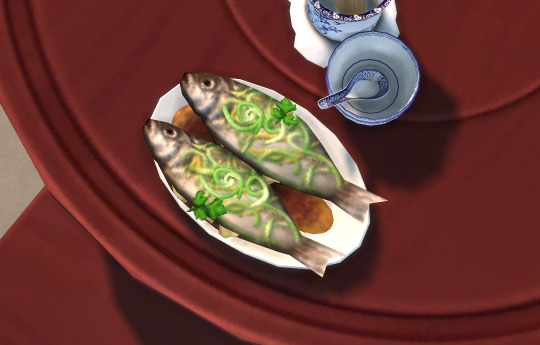
In Chinese, "fish" (鱼 Yú /yoo/) sounds like 'surplus'. Fish is a traditional Chinese New Year dish on the Chinese New Year dinner menu. Chinese people always like to have a surplus at the end of the year, because they think if they have managed to save something at the end of the year, then they can make more in the next year.
Steamed fish is one of the most famous Chinese New Year recipes. What fish should be chosen for the New Year dinner is based on auspicious homophonics.
Crucian carp: As the first character of 'crucian carp' (鲫鱼 jìyú /jee-yoo/) sounds like the Chinese word 吉 (jí /jee/ 'good luck'), eating crucian carp is considered to bring good luck for the next year.
Chinese mud carp: The first part of the Chinese for "mud carp" (鲤鱼 lǐyú /lee-yoo/) is pronounced like the word for gifts (礼 lǐ /lee/). So Chinese people think eating mud carp during the Chinese New Year symbolizes wishing for good fortune.
Catfish: The Chinese for "catfish" (鲶鱼 niányú /nyen-yoo/) sounds like 年余 (nián yú) meaning 'year surplus'. So eating catfish is a wish for a surplus in the year.
Eating two fish, one on New Year's Eve and one on New Year's Day, (if written in a certain way) sounds like a wish for a surplus year-after-year.
If only one catfish is eaten, eating the upper part of the fish on New Year's Eve and the remainder on the first day of the new year can be spoken with the same homophonic meaning.
Fish is an auspicious Chinese New Year symbol.
Glutinous Rice Cake — a Higher Income or Position
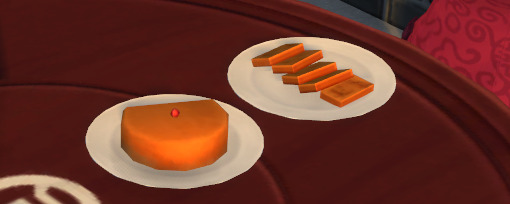
Chinese New Year cakes
Glutinous rice cake (年糕 Niángāo /nyen-gaoww/) is a lucky food eaten on Chinese New Year's Eve. In Chinese, glutinous rice cake sounds like it means "getting higher year-on- by year". In Chinese people's minds, this means the higher you are the more prosperous your business is a general improvement in life. The main ingredients of niangao are sticky rice, sugar, chestnuts, Chinese dates, and lotus leaves.
Longevity Noodles — Happiness and Longevity
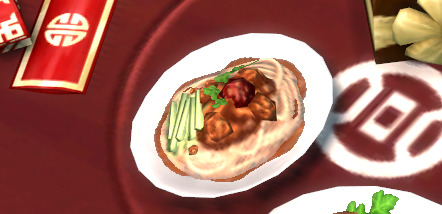
Longevity noodles (长寿面 Chángshòu Miàn /chung-show myen/) unsurprisingly symbolize a wish for longevity. Their length and unsevered preparation are also symbolic of the eater's life.
It is a lucky food eaten on Chinese New Year Day in North China.
They are longer than normal noodles and uncut, either fried and served on a plate, or boiled and served in a bowl with their broth.
Good Fortune Fruit — Fullness and Wealth
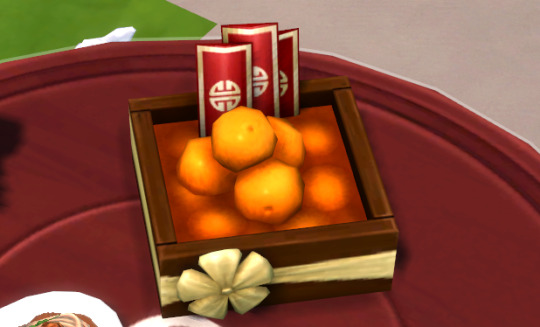
Certain fruits are eaten during the Chinese New Year period, such as tangerines and oranges, and pomeloes. They are selected as they are particularly round and "golden" in color, symbolizing fullness and wealth, but more obviously for the lucky sound they bring when spoken.
Eating and displaying tangerines and oranges is believed to bring good luck and fortune due to their pronunciation, and even writing. The Chinese for orange (and tangerine) is 橙 (chéng /chnng/), which sounds the same as the Chinese for 'success' (成). One of the ways of writing tangerine (桔 jú /jyoo/) contains the Chinese character for luck (吉 jí /jee/).
Chinese Dumplings — Wealth

With a history of more than 1,800 years, dumpling (饺子 Jiǎozi /jyaoww-dzrr/) is a classic lucky food for new year, and a traditional dish eaten on Chinese New Year's Eve, widely popular in China, especially in North China.
Chinese dumplings can be made to look like Chinese silver ingots (which are not bars, but boat-shaped, oval, and turned up at the two ends). Legend has it that the more dumplings you eat during the New Year celebrations, the more money you can make in the New Year.
Source: LinkedIn by Manette Chen
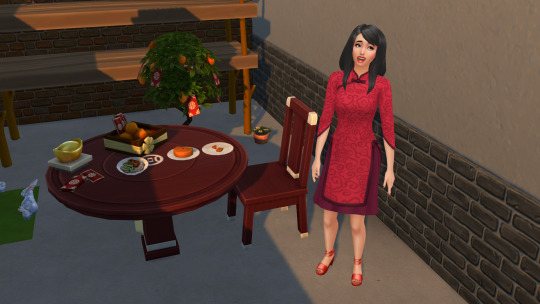
As for fashion... I'm not woman so I am not expert about women fashion, I can tell this clothing is not Chinese Qi Pao. My girlfriend and female family members do not wear that kind of Qi Pao. This is more like Ao Dai, Vietnamese traditional dress. There's skirt beneath dress. Source: Wikipedia
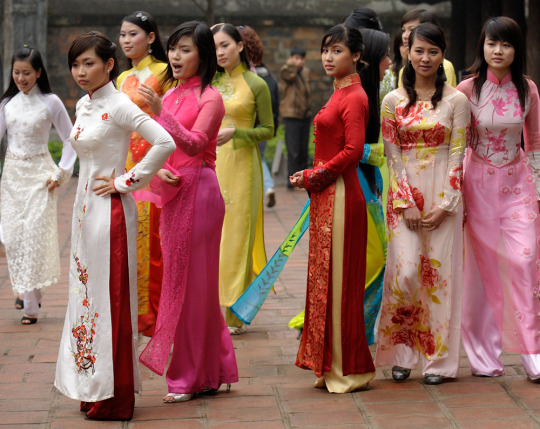
The rest of clothing is typical modernized clothing, which is much more realistic because we Chinese when at Chinese New Year gathering we wear red coloured modern clothing and not dress like in ancient times. Usually kids who wear Qi Pao because they are very cute to dress like that.
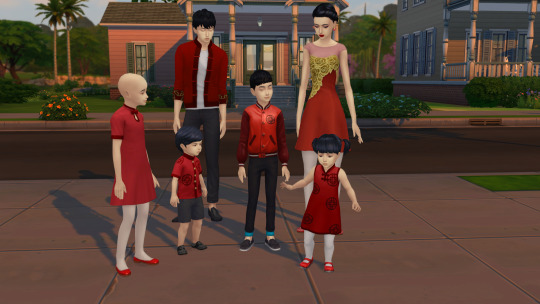
#the sims 4#ts4#ts4 chinese#chinese culture#ts4 asian#ts4 lunar new year#ts4 chinese new year#春節#新年快樂#模擬市民4#nian gao#red envelope#orange#red#fish#noodles#dumplings#jiao zi#hong bao#ang pao#2024#asian representation
17 notes
·
View notes
Text
The Travellers, Vol 12, Pt 3: The Civilization
Non-variants would soon enter the picture. The team members would have natural born offspring. They would encounter the pre-existing inhabitants of the British Isles. More newcomers might arrive from the continent. It was vitally important therefore that their culture and civilisation had a coherent and complete form. They needed concepts that were expressed in language, technology, art, music, myth, and philosophy to tell their own people, and those they met, who they were. Naturally, they all had their stories straight on this score. They had been thinking about it and trying stuff out for long enough. Their ideas would inevitably be subject to change over time as non-variants became increasingly significant players in the cultural, political, economic, and intellectual development of their society, and this was a desirable phenomenon from their perspective. Nevertheless, the starting position was critical.
[[MORE]]
On top of the increasing presence of non-variants, there were the criteria by which the team would ultimately judge the success or otherwise of their mission. Although they possessed more latitude than before in the means through which they might be realised, these were little different to the goals they had consistently pursued through all of their interventions.
The crew wanted the civilisation they built to be as equitable and meritocratic as possible without imposing oppressive homogeneity that impinged upon vital creativity, liberty, and difference. They aimed for it to value peace and be open and welcoming to others while being sufficiently strong and coherent to resist aggression and threats to its integrity when necessary. It was important that it would value and reward knowledge, skill, inventiveness, and human achievement yet possess a sufficient level of wisdom and humility to maintain a critical attitude towards itself and remain appreciative of its relationship to, and dependence upon, other cultures and the natural world. The people should be both capable of and willing to educate and nurture their young and care for their sick, elderly, and disabled. Also, it should be fun loving, not take itself too seriously, and have a sense of humour and an enjoyment of entertainment that did not revolve around cruelty and humiliation.
At the heart of many cultures, one can find a concept of truth, even if it is only tacit. Indeed, cultural identity as such might be described as a set of humans defined by the presence of a sufficient degree of correlation in their beliefs concerning what is or is not true. For everyday purposes, this concept of truth needs to be simple and intuitive enough for most people to be able to apply it instinctively most of the time.
The variants would deploy a concept of truth that drew on correspondence, coherence, and pragmatic theories. In broad outline, this held that something was true if it could be demonstrated in practice to correspond to an actual state of affairs and did not contradict other known truths (in which event one must be false). This formulation, which probably appears rather simple and obvious to someone from MOT raised in the Western philosophical tradition, has far reaching and significant implications.
Clearly, it demands a language grammar and vocabulary for expressing truth statements. However, it further suggests the concept of the “experiment” which necessitates shared systems of quantification and measurement. These amplify the importance of literacy and numeracy, which in turn transform one’s relationship to a host of phenomena, including time and memory. Although they would start slowly, the culture of “Albion” that the variants were developing would start at the outset with an alphabet based on Latin, a base-12 floating point numeric system with a zero concept derived from Indo-Arabic numerals, and units of measurement for length, angles, area, mass, volume, time (a lunisolar calendar, sundials, and sand or water timers), and even temperature (using bi-metallic strips).
They would benefit from a whole matrix of technologies that are either necessarily associated with, or can be easily inferred from, the existence of some of these ideas that would form the basis of their civilization. Some of these I have already mentioned: blades, bows, saws, shovels, picks, planes, hoes, wheels, sails, pulleys, levers, screws and the like. Others such as pens, ink, and paper were also in the mix. Indeed, there were so many that it is probably more illustrative to provide some examples of things that were most definitely not going to be given in this context.
Things like heat engines, electricity, the wave character of light and sound, the atomic nature of matter, the functioning of planetary and stellar rotations and orbits: all of these are non-obvious ideas that can be modelled in different ways for practical purposes and the accurate elaboration of which typically depends on a whole series of complex intellectual and technical developments. The new society the team was building would know nothing of these things at the outset. So long as you could potentially measure the angle of the sun, the speed of something or other, or the temperature of an oven, that was a sufficient starting point.
It should be self-explanatory by now that any society capable of developing this kind of intellectual and technical base within a fairly short period of time could not be theocratic. They had to have been people who valued knowledge and believed that it could be obtained through human action and thought, rather than simply being conferred upon them from above. Nevertheless, plenty of unknowns remained and they would require an ethical framework of higher order concepts to prevent them doing harm to themselves, others, or the world in general. Moreover, such matters would necessitate narratives to facilitate the effective communication of abstract ideas in addition to providing an explanatory structure for the origin of things and the nature of certain unknowns. Last, but by no means least, it would be convenient for the variants if these made it easier for them to do some of the more magical things they needed to do, such as substitution of their own children.
Despite their modernist aims and conceptions of truth, the variants were not naive positivists. They had no desire to peddle scientism and were well aware of the fact that people often need a belief system that provides meaning, purpose, and the possibility of redemption, even if it is essentially untrue. Shared systems of faith also provide a valuable tool for developing and sustaining social coherence. However, since they would almost certainly evolve into an organised religion over time that fed into myriad political and economic aspects of the civilisation, the choice concerning what to believe was vital.
Therefore, beyond simple binary notions of true and false, their frameworks of thought, language, and grammar would support ternary or even quaternary truth concepts, the additional positions within which might be summarised as “not true” and “not false”. These named the unknowable, the unnameable, or that which was in the process of being disclosed or concealed. Consequently, falsehood was not an absolute negation of truth per se but an independent idea of “untruth” that existed on a scale between it and the verified truth along which belief might be held as true or false in particular ways or pending certain facts.
At its root, the variants had developed a collection of mythological narratives over the years that told the story of the creation of the universe from the nothingness of the Big Bang and the ensuing collisions of matter in space, but in a highly simplified and anthropomorphised form. This creation myth ultimately ended with the births of numerous constellations of stars, the sun (“Haul”), the moon (“Lun”), and earth (“Naear”). Ultimately, there were also figures in this pantheon for all the major features of their immediate landscape, such as the British Isles as a whole (the giant “Albion”), the islands of Britain (“Pryddana”) and Ireland (“Eriu”), right down to important hills and rivers (such as “Tamesis” and “Hafren”).
At the outset at least, and on the part of the variants, there would be little pretence that these were anything other than stories which helped explain certain aspects of the world which they had left unexplained, guide ethical action, and aid a few more practical concerns, such as navigation.
The ternary concepts of nothingness and somethingness along with the disclosive space in between would be fundamental to their myths in other ways too. Aside from providing an illustration of numeric concepts, they established a context for the “otherworld” (which they called “Annwn”) of things like birth, death, dreams, and intuition. The emergence of life from nothingness and its subsumption into death was elaborated as a symbiotic cycle in which all the elements of the visible waking world were balanced by counterparts in the otherworld of Annwn.
Annwn provided a valuable spirit world which opened the way to the notion of communication with, traversal between, or even return from it. In addition to facilitating substitution, it enhanced the sacrality of the natural world in a manner that could be leveraged to promote care for it. It also riffed on ideas such as ying/yang and karma: a death and departure from the waking world was a birth or arrival in Annwn and vice-versa. The spirit of those thought to have been good in life might return in a new form to help overcome evil in this or those who had committed wicked acts might win redemption in the world of the spirits if they learned the error of their ways and atoned.
Over the long term, the maintenance and telling of these stories would be the province of a technocratic class of learned men and women known as the “derwid”. These people would be less a “priesthood” than an intellectual caste who, aside from telling didactic stories which made abstract concepts more tangible, would serve as philosophers, scientists, engineers, doctors, surgeons, architects, lawyers, historians, and artists. Their numbers would be heavily skewed toward variants, and their exclusive hold over advanced knowledge throughout the early years of their culture (before they began to write books) would help to obfuscate their origins in the mists of time.
Alongside these myths was another tranche of stories which we might call legends or folktales that, while still used by the derwid, were not their exclusive domain. These legends provided origin stories and role models through narratives that were centred around definitively human action. They involved figures such as the prototypal derwids, Orin and Aeron, the valiant leaders, Lugh and Lleua, and the nurturing leaders, Ceri and Carys, the smith, Gofannon, and the farmer, Amaethon among many others.
The myth and legend cycles also lent explanatory power to other phenomena and social structures, especially the calendar. As had been the case whenever possible on prior missions, the variants were going to be using their preferred perennial lunisolar system. However, they had made a few modifications to its structure.
The year would be split into 52 weeks (with 1 to 2 intercalary days) that provided a rhythmic structure with regular breaks from work every 7th day (known as the “setath”). These sat within a larger structure consisting of four seasons, each around 12 weeks long, that were divided by the week-long festivals of Ostara, Litha, Mabon, and Gheol that were set around the solstices and equinoxes. These seasons were further subdivided into two halves by the lesser festivals of Imbolc, Beltane, Lammas, and Samhain. The precise points in the tropical year at which these occurred would move over the coming millennia as the inclination of the earth’s axis changed, so their calculation was inevitably the province of the derwid. The variants fully intended to introduce thematic ceremonies as a focal point of these festivals. However, they would mainly be an opportunity for people to let off steam and have a good time.
The cycles of the seasons were loosely reflected in a series of tripartite divisions for the path of life. The period from birth until 6 years of age was considered to be a period of infancy during which there were few social expectations other than to survive, grow, and learn the basics of movement and speech. Upon reaching one’s 6th summer, one would be initiated into the community during the festival of Litha. From then until the age of 12, one became properly a “child” and expected to learn the fundamentals of knowledge, including reading, writing, and maths that would lay the foundations for your participation in society. Another rite followed in your 12th summer when you officially became a “youth”. At this point, while still not a fully-fledged member of one’s tribe qualified to do things like swear oaths or bear witness, you would gain the right to do things like carry a knife (which you would be given) and would be held accountable for your actions. During one’s youth, between the ages of 12 and 18, you would continue to learn but also start to contribute by taking apprenticeships or being packed off to study with the derwid. At the age of 18, you became a fully-fledged adult with all the responsibilities that came with that status. In addition to being gifted symbolic artefacts during each of these rites of passage, one was tattooed as a permanent mark of attainment and belonging. However, your life was hopefully far from over.
The three stages of development (infancy, childhood, and youth) were followed by three further stages of adulthood, each again lasting 6 years, during which one was expected to gain first knowledge, then experience, and finally wisdom. If one reached the age of 36, one gained elevated status as an elder. Nevertheless, once again, one’s development was hopefully not finished yet. The third meta-phase of life was similarly divided into three stages of “evaluation” or “consideration”, “compassion” or “insight”, and “judgement” or “transcendence”. However, this time each period lasted 18 years. Frankly, if you lived much beyond 90 years in the absence of modern medicine, vaccines, and antibiotics it was a miracle. But it wouldn’t be unheard of in their society.
All these beliefs and rites naturally informed the political and economic structure that their civilisation would adopt, at least at the outset. It should come as no surprise that it would probably best be described as a technocratic gerontocracy.
Although their members would often be embedded within settlements, the derwid would ultimately form a tribe apart consisting of experts and specialists who were frequently itinerant. It was regarded as a vocation, rather than a job. While it would be taboo to refuse hospitality to one of their number, and unadvisable to shun their aid or advice, they would receive no remuneration for their work and would not constitute any formal part of political administration as such. Similarly, while everyone was required to learn a variety of combat skills from the age of twelve, train regularly, and do their duty when called upon to do so, derwid were not required or even expected to fight, although many would.
On a day-to-day basis, tribal affairs at a local level would be governed by a council or assembly of the elders (i.e. those of 36 years of age and above) known as the “laenoriad” who would elect a leader. This leader, who gained the honorific title “Ben”, did not necessarily need to come from among their number: it could be any nominated adult (i.e. at least 18 years of age). This chief would also serve as a judge with the laenoriad functioning as a jury. Thus, they would collectively form the legislature, the executive, and the judiciary. Beyond these outline constraints, how they arranged their affairs internally was entirely up to them to decide, but the principle that power came with responsibility which could only exercised effectively by those in possession of wisdom and that power was conferred (or revoked) through an act of consensus were both key. Eventually, as the number and size of settlements increased, a hierarchical series of supra-tribal councils would emerge consisting of all the leaders from a particular region and from across the British Isles as a whole.
Another important problem that it was vital to nail early on were the systems of distribution and exchange. Even when they only had the one settlement, people would not be able to do everything for themselves and stuff would need to be shared around. There were several basic options.
Barter is commonly regarded as a kind of default solution to the problem of exchange. In the absence of any other formal mechanism, this is correct insofar as people will arbitrarily exchange things in their possession or power to obtain others that are not which they need or desire, on an ad hoc basis. As a fallback, it is something that is liable to occur in any context. However, as a systemic approach it is deeply flawed. Barter encourages the appropriation and hoarding of resources, often through the violent exercise of power. It rapidly degenerates into a social order based on brute force that exhibits extreme forms of oppression and inequality. This is why it is typically regarded as an inverse index of civilization. Its very presence is indicative of barbarism.
A widespread early alternative was the so-called “palace economy”, or command economy, in which all resources are pooled with a central authority that is subsequently responsible for their distribution based on whatever criteria are deemed to be appropriate. While this method can in theory be egalitarian, it is deeply susceptible to corruption and tyranny. Moreover, by building in a single point of failure it becomes prone to political instability since, whenever failure occurs, there is typically no fallback other than a return to barter.
Another solution that was often developed in the ancient world was that of the gift economy. These often demonstrated beneficial side effects in terms of things like social coherence and trust. They operate through the extension of a form of loan in which goods or services are advanced by one party in return for social credit and the expectation of a return on this investment at a later date. Such things are all well and good but, as an exclusive system, it rather limits the ability of people or groups to proactively secure the resources they need right now. Consequently, it often tends to exist in conjunction with other forms of exchange, such as barter.
Then of course there are market economies. Obviously, that is a big and complex topic. I use the plural “market economies” deliberately because there are many different types of market, only one of which is the ideologically charged concept of a “capitalist free market” economy. For my purposes here, I am going to define a market economy as a set of one or more governed forums that exist within the context of the same coherent legal framework in which individuals or groups exchange goods and services via an intermediate form that consists of a representation of value.
Markets are an excellent structure for exchange. Their capacity to adopt a distributed, cellular form gives them the potential to be flexible and resilient. However, from the standpoint of the above definition, they are merely the bread in an economic sandwich that one loads up with the desired ideological fillings. These fillings are typically embodied in the legal frameworks of governance and the intermediary form utilised to represent value as an exchange medium.
The variants had never lost their agreement with certain fundamental aspects of a Marxist analysis of capitalism. Indeed, they had developed their position to an unparalleled degree of refinement over the years. One of Marx’s arguments with which they agreed was that, within the context of a capitalist market economy, the exchange value of commodities is ultimately regulated by socially necessary labour time. However, unlike Marx, they did not support a commodity theory of money. In their view, things like the gold specie standard merely served to obfuscate the more accurate description of money as an expression of purchasing power that ultimately reflected social status and class. Money in this context was always an abstract relative value, even if one rather foolishly chose to base one’s currency system on a scarce commodity. On past missions, the team had adopted metallic currencies for reasons of expediency and inherited context. Now that they were freed from such constraints, they were going to go down a different path.
The unit of currency in their new civilization would be based on labour time. In principle, this can be used to determine both wages and prices. For example, let’s say that 1 currency unit is equal to 1 hour (as defined at the point of the summer solstice, since they were using sundials, and winter and summer time divisions were of differing absolute duration).
Now let’s say for the sake of an example that, on average, a baker can produce 10 loaves of bread per hour, a potter can make 1 pot per hour, and a blacksmith can make 1 blade in 10 hours. In theory, the baker’s “wage” production costs would be 0.1 currency units per hour while the potter would earn 1 unit and the blacksmith 10 units; i.e. assuming that all the commodities they produce have an equal use value, we can posit their wage rate as 1 hour divided by the average number of these commodities that are produced per hour. The sale price would then be the wage cost plus the price of the materials required to produce it. Thus, ignoring the cost of materials and other capital expenditure, they each earn 10 currency units from the sale of the produce from 10 hours of labour time.
However, this can penalise time intensive functions or promote redundant production on the false assumption that all commodities are of equal value. In reality, practically no one was a wage labourer in their society anyway. Certainly not yet. When that phenomenon did rear its ugly head, wage levels would be set in the usual “capitalist” way as a function of supply and demand combined with political pressure and negotiation. In the variants’ civilization, at least at the outset while the economy remained very small and simple, prices would be determined firstly by the derwid as a function of a determination of socially necessary labour time such that everyone possessed a more or less equal purchasing power that would enable them to obtain an equitable share of the total available produce, and secondly by the laenoriad as a means of promoting socially necessary production.
The critical point about using time hours as an index of currency value was that debts would be redeemable at the last resort through the one resource to which everyone had free access: time. Moreover, it provided a tangible baseline for assessments of value with easily understood judicial ramifications. Nevertheless, once again, it wouldn’t work in practice that if you lent your mate Bob a tenner and he failed to pay it back you could literally make him work as your own indentured slave for a period of time. Like any debt in our world, you would have to lodge your claim in court. If the loan agreement was deemed to be legal, and Bob was found to have defaulted, then the “state” would simply issue the money to pay you what was owed and a certain amount of either Bob’s time or income would revert to the state for use in the public interest. Or their own personal enrichment, depending on how your tribe was running itself at the time.
This legal procedure also indicates how money would come into existence: the state would simply create it and spend it into circulation. Once again, time-based monetary units help to provide an indication of how much money should be created since the total value of all currency in circulation should be sufficient to pay everyone for all their time. In the case of our crude baker, potter, and blacksmith example, if these were the only three people in your economy, then you would need to issue the equivalent of 11.1 units per hour of work to be completed.
One of the other major questions that needed to be addressed was the physical form that the currency would take. Part of the appeal of metallic currencies was that, even in the event of the collapse of the issuing authority, people still had faith in the idea that the base metal itself would be accepted widely enough as a barter exchange medium. Moreover, making coins from expensive scarce materials over which it was comparatively easy to exert monopoly control discouraged counterfeiting. Paper money, as one alternative, lacks both qualities. Matters such as theft and durability are also pertinent issues. For the variants, the answer to these questions lay in the comparative simplicity of their society and economy and the control it would exercise over markets through its legal framework.
They intended to largely resolve the questions of theft, counterfeiting, and durability by simply not issuing the currency in a physical form at all. Or, rather, by inventing a form of banking and operating this as an exclusive state monopoly.
On market days, or at any other time one wished to go shopping or do business, one would visit the bank and make a withdrawal from one’s balance. In return, one would receive some suitably authorised paper scrip (or a quantity thereof in various values) which named you as the owner of this money and detailed the date on which it was issued and the date when it would expire (usually no more than 1 day). When you purchased something, you would name the recipient and add your own signature in the relevant space. The recipient would then return it to the bank at the end of the day’s trading at which point a balance transfer would be completed.
If you wished to shop at another, more distant, market you could still use the same scrip, so long as it had not expired. It would eventually be reconciled and, if you ran up a line of credit this way by racing back home and withdrawing more, you would soon be caught and punished. You would owe money or labour time in accordance with the court’s estimation of the rate at which this should apply.
Alternatively, you could carry a simple dated balance statement which would be added to your account at the destination following which you would be able to withdraw scrip in the usual manner. However, you would not be able to withdraw any more scrips from your “home” bank until you returned the updated balance document which would have been given to you when you banked the scrip at the distant market.
For foreign trade, you would need to withdraw scrip to purchase gold, silver, or some other commodity for use in a barter exchange. That’s what international trade is at heart. Especially in the days before globalisation. Certainly, it barely even existed at the time the variants were currently living in, and it would be a very long time before it was regulated at all.
Thus their “bank” was more of a “tally shop”. Money was simply a temporary localised physical representation of part of this balance; a series of chits and tokens produced on cheap, plentiful, ephemeral material for the purpose of value exchange and transfer. It did not bear interest and, although it could potentially be loaned, the charging of interest on such would be specifically prohibited. Courts would be under no obligation to bail you out for irresponsible loans. The creation of the money in the first instance would be entirely the province of the state who would simply spend it into existence via an act of accounting.
Of course, in the early days of their settlement, hardly any money was used, and no one really needed to worry if they had none. The essentials of life were shared freely and, since the population consisted overwhelmingly of variants, there was practically no conflict or contention over this.
Indeed, one might wonder why they didn’t simply operate a much simpler palace economy. Such a system would have satisfied their needs at the beginning. However, for the reasons noted above, it wouldn’t scale effectively. Moreover, a well-governed market economy utilising a sensible currency system can be liberating.
In a command economy, one is effectively an employee of a single monolithic state bound to follow their instructions concerning what to produce. You are subsequently given very little choice about what one consumes and when. Selling into and buying from a market allows one to choose what one produces or consumes, how much, and when. If you want to blow all your credits on ale, then go for it. Alternatively, if you have a yen to try making something radically different, you can have a pop.
The idea that someone might try and fail brings us conveniently on to the topic of welfare and other forms of social care and the structures that surround them. On the whole, this was a non-problem for them. The way in which their currency worked meant that, so long as they didn’t issue so much credit that there was inflation, it was positively beneficial to the economy for them to run social programmes and infrastructural development projects.
The derwid would be nominally responsible for healthcare and education. However, they wouldn’t be able to do it alone. Special buildings would need to be constructed. Nurses, assistant teachers, and other supporting staff would be required. Raw materials would be a regular input. Associated with primary medical care, there would almost certainly need to be some provision for palliative and old age care which came with similar requirements.
There will always be a few people who simply don’t want to be a part of your society and wish to have little to do with your carefully organised institutions. They should not be unduly punished for this. Contrariwise, one of the fundamental goals of the variants’ economy was that no one should suffer from want due to misfortune in life or by birth. Nevertheless, it was not intended to be a free-for-all. A lot of work needed to be done. From everyone according to their ability would be a basic tenet. Thus, their general welfare provision would mainly consist of the creation of currency for the purposes of direct employment by the state where necessary. This would be supplemented by ad hoc debt jubilees and regular citizen dividends.
Beyond the political, economic, and judicial concerns of the state lay many diverse cultural questions that ranged from matters such as childrearing all the way to seemingly trivial matters like fashion. The variants considered all of them to be of vital importance, even those that might appear frivolous. I will deal with only the two mentioned above at this point.
At a fundamental level, the civilisation of Albion would eschew many notions concerning both the nuclear family and private property. Individuals of any gender would be at liberty to commit themselves exclusively to each other for sexual or other purposes, and there would be ceremonies associated with this process that enabled the oaths made to be recognised in official contexts. However, there would be absolutely no necessity to commit in such a manner. When it came to sex and reproduction, the free consent of all parties was assumed to be the primary imperative. Any offspring would inherit their primary identity in a matrilineal manner and, while a social and legal onus would be placed on both parents to ensure their children fulfilled their obligations, child rearing would predominantly be undertaken by the “clan” as a whole.
This collectivism fed through into property law. As a member of a clan, one would gain certain rights and protections, including matters such as having one’s basic needs for food and shelter met. One might occupy a house or a farm that could be considered “your property”, by virtue of fulfilling a particular role within a particular group, with which you were free to do as you wished. However, this did not confer the right to exchange it: it remained the property of the clan from whom it could not be alienated. The same applied to all land. Property was something one gained as a form of privilege through the fulfilment of a responsibility or obligation. This applies as much to the tribe, whose land belonged to the natural world of which they were to serve as guardians, as it did to the individual.
2 notes
·
View notes
Text
Totally Spies! (Reboot)
Alejandra “Alex” Yue Casoy-Huang
Full Names: Alex, Alexia, Alexis, Ally, Al, Soccer Girl, Mèi Mèi, Jiē Jiē
Ages: 14
Gender: Female (She/They)
Ethnicity: Southeast Asian (Chinese Filipina)
Hair Color: Dark Brown (with yellow streaks)
Eyes Color: Amber Brown
Skin Color: Light Brown (with olive brown vitiligo)
Occupation: High School at Beverly Hills High School, team captain of girls soccer team, club member of Chinese culture and mahjong club, spy, WHOOP agent
Home: Beverly Hills, California (born in Philippine)
Family Members: I lived in a garden house with my māmā (mom), my bábá (dad), my gēgē (older brother), my mēimēi (younger sister), and my nāināi (paternal grandmother)
Friends: Sam and Clover who’s in my new friends, and we went to classes together, Sam is a team captain of Bev. High girls basketball team and Clover is the head cheerleader of Bev. High cheer team, I’m the team captain of Bev. High girls soccer team, I’m also the member of Chinese culture and mahjong club.
Ideal Boyfriend: I’m interested for LGBT in school, I’m panromantic demisexual, sometimes I’m not interested in date, I’ll date someone someday.
Roles: I’m the most martial artist and the athletic tomboy of the trio.
Fashion Choices: I like to wear tomboyish sporty, jejemon and cyber grunge clothes and accessories including golden hoop earrings
Cliques: Anime Athlete/Gamer Girl
Likes: animals (except pigs), sports (except soccer), martial arts, martial arts and sports movies, video games, my family and my friends, Chinese hip hop and Pinoy rock musics, stopping crimes against humanity, Chinese/Holiday holidays (like Chinese New Year and Mid Autumn Festival), Chinese foods, Filipino foods
Dislikes: Evil, bullies (except Mandy), threats, comedy movies, cats, animals abuses, mean girls, being treated like a child, being babied, mushrooms, candies, crimes, roasted pigs, fish stews, thieves, creepy dolls, vampire movies, werewolves movies, dangers, coconuts
Fun Fact About Alejandra “Alex” Yue Casoy-Huang
Alex loved sports and martial arts including soccer, skateboarding, swimming, cycling, cross country, Kung Fu, wushu, karate and taekwondo. Before becoming a spy, Beverly Hills High started a female soccer team. After the tryouts, Alex was nominated as a team captain of Bev. High girls soccer team. Her younger sister like to play sports just like her. (Her older brother doesn’t care about sports like her younger sisters) or her father’s likes from earlier years. Even though her parents bought her soccer uniforms and a soccer, they signed her up for Soccer Stars, when she was a toddler in preschool.
Alex likes anime series for teens, she is an anime lover, she listened to Chinese hip hop and Pinoy rock musics. She’s reading manga in her room and during lunch. Her older brother is also an anime fan and they watched Creature Slayer on Netflix. She and her older brother likes to watch Judokas: Master of Ninja Jitsu with her younger sister. She train in martial arts from her paternal grandmother. She is a wonderful martial artist.
Alex loves animals, her family volunteered for petting zoos. She like her pet pig, Oinky, her older brother is going to be a zookeeper to work with the animals, he study biology at high school. She is very allergic to cats, a type of animal allergy, is one of the most common allergies experienced by humans similar same as the original Alex. Alex dislikes roasted pigs, as a child, she dislikes animal abuses, she save Oinky as a piglet.
Alex’s favorite Chinese holiday are Chinese New Year and Mid Autumn Festival, the Chinese New Year is a festival that celebrates the beginning of a new year on the lunisolar Chinese calendar, the Mid Autumn Festival is a harvest festival celebrated in Chinese culture.
Although Alex always eat healthy foods include chicken lo mein, chow mein, steamed rice, noodles and jiaozi (dumplings). She tried to eat moon cakes, she hated mushrooms and she can’t not to eat mushrooms, candies and other sweets, she is the most fitness of the spies. She also like to eat her favorite Filipino dish is Mami soup from her birthplace in the city of Manila. Philippine.
0 notes
Text

Send from Sansgreet Android App. Sanskrit greetings app from team @livesanskrit .
It's the first Android app for sending @sanskrit greetings. Download app from https://livesanskrit.com/sansgreet
Akshaya Tritiya.
Akshaya Tritiya, also known as Akti or Akha Teej, is an annual spring time festival of the Hindus and Jains. It falls on the third Tithi (lunar day) of Bright Half (Shukla Paksha) of Vaisakha month. It is observed as an auspicious time regionally by Hindus and Jains in India and Nepal, as signifying the "third day of unending prosperity".
The festival date varies and is set according to the lunisolar Hindu calendar, and falls in April or May of every year in the Gregorian calendar.
#sansgreet #sanskritgreetings #greetingsinsanskrit #sanskritquotes #sanskritthoughts #emergingsanskrit #sanskrittrends #trendsinsanskrit #livesanskrit #sanskritlanguage #sanskritlove #sanskritdailyquotes #sanskritdailythoughts #sanskrit #resanskrit #akshayatritiya #vaisakha #springfestival #hindufestival #hindus #jains #rishabhdev #lordkrishna #hinduism #jainism #nepal #indianculture #lordvishnu #celebratingsanskrit #donation
#greetingsinsanskrit#sanskritgreetings#sanskrittrends#trendsinsanskrit#livesanskrit#sanskrit#celebratingsanskrit#incredibleindia#indianarmy
0 notes
Text


✦ PARTNERS
pt: partners. end pt.
the slurrrrrrrs (TEAM 01) — @hysangel + @local-maneater
paws and claws (TEAM 02) — @nostalgiagender + @zoeymogai
THE SWARM (TEAM 03) — @smilepilled + @floraeth
amongai (TEAM 04) — @robofox-mogai + @dragonpride17
TEAM 05 — @kylertism
The mogaierrrrrs (TEAM 06) — @francicide + @mewgai
orientation hater duo (TEAM 07) — @acronym-chaos + @boingogender
digipet duo (TEAM 08) — @snoopyghibli + @flutteringwings-coining
Mogai Mitlas (TEAM 09) — @novaurora + @catboy-autism
camp liminal (TEAM 10) — @love-letterworm + @xyrthemost
Mystical Mysteries ! (TEAM 11) — @cannibalisticcoinz + @bluecube-coins
Kiteon (TEAM 12) — @kitsflagz + @jiiamp
lunisolar (TEAM 13) — @idwl + @daybreakthing
note: this post will be updated in the future when teams get back to me with their decided names if they don't already have them!

32 notes
·
View notes
Text
This is my team forever Baltimore Ravens not just when we win shirt
This is my team forever Baltimore Ravens not just when we win shirt
It’s called the Lunar New Year because it marks the first new moon of the This is my team forever Baltimore Ravens not just when we win shirt calendars traditional to many east Asian countries including China, South Korea, and Vietnam, which are regulated by the cycles of the moon and sun. As the New York Times explains, “A solar year the time it takes Earth to orbit the sun lasts around 365 days, while a lunar year, or 12 full cycles of the Moon, is roughly 354 days.” As with the Jewish lunisolar calendar, “a month is still defined by the moon, but an extra month is added periodically to stay close to the solar year.” This is why the new year falls on a different day within that month-long window each year. In China, the 15-day celebration kicks off on New Year’s Eve with a family feast called a reunion dinner full of traditional Lunar New Year foods, and typically ends with the Lantern Festival. “It’s really a time for new beginnings and family gatherings,” says Nancy Yao Maasbach, president of New York City’s Museum of Chinese in America. Three overarching themes, she says, are “fortune, happiness, and health.

0 notes
Text
three things that are currently in pride of place for “i think of this and my brain clicks happily”
- ORBATs - lunisolar calendars - the arrangement of sports teams within a league
1 note
·
View note
Photo

November 4th is...
Candy Day - Originally a form of medicine, candy calmed the digestive system or cooled a sore throat. At that time, combined with spices and sugar, candy only appeared in the purses and the dishes of the wealthy. By the 18th century, the first candy likely came to America from Britain and France. At the time, people made the simplest form of candy from crystallized sugar – rock candy. However, even the most basic form of sugar was considered a luxury and only attainable by the wealthy.
Cash Back Day - RetailMeNot founded National Cash Back Day in 2019 to celebrate shoppers by giving them the gift of cash back. Hundreds of retailers are participating in Cash Back Day to help shoppers get a head-start on their holiday lists. With Cash Back Day, shoppers can save money early in the season and then get their payout right before the holidays for any last-minute essentials or to spend on themselves during post-holiday sales.
Chicken Lady Day - Honors Dr. Marthenia “Tina” Dupree. For 12 years, Dr. Dupree worked for the second-largest chicken restaurant in the world as the Director of Community Relations and Training. She was widely known due to her work in the community. During this time and through her work with the community and the people she helped, Dr. Dupree became known as “The Chicken Lady.” Dr. Dupree led numerous efforts to improve education in her community. She provided training and certification that led to business opportunities to many in her area. She not only led by example, but she enhanced the lives of those around her.
Diwali - Every year Hindus, Sikhs, and Jains around the world celebrate the Indian Festival of Lights called Diwali. This celebration lasts five days and takes place during the Hindu lunisolar month, Kartika. On the Gregorian calendar, the festival falls between October and November. Diwali is the biggest holiday of the year in India. The festival symbolizes the spiritual victory of light over darkness. Diwali also celebrates good over evil and knowledge over ignorance. The festival is associated with Lakshmi, the goddess of prosperity. Diwali is also linked to other Hindu gods, including Vishnu and Krishna.
International Project Management Day - Businesses, corporations, and nonprofit organizations all around the world employ project managers. These professionals play the lead role in the planning, procurement, and execution of a project. It’s their job to get the entire team on board to successfully complete various projects. The job can be stressful as they are often working against tight deadlines and with strict budgets.
International Stout Day - Stout is a dark, top-fermented type of beer known for its creamy and robust flavor. It’s also known for its rich dark color. Some stouts are so dark; they are almost black thanks to a black patent malt. People first started brewing stouts in the 1700s. They developed the stout from porters, which is a dark ale. There are two main categories of stout: sweet and dry. Sweet stouts are made with lactose derived from milk. They were first made in the United Kingdom. Dry stouts, also called Irish stouts, were first made in Ireland using roasted barley.
Men Make Dinner Day - This day was created for the men who do not know their way around the kitchen and are not familiar with cooking appliances, as well as for the women in their lives who need a break.
Use Your Common Sense Day - Every day we see complete fails of Common Sense, stupid and fantastic examples of the horror that can occur when someone just… refuses… to think. Sometimes it’s a matter of hubris, people thinking that their over-inflated sense of self-importance can overcome the laws of physics. Other times it’s just a complete failure to take a moment to really think a thing through, and thus do something monumentally stupid. Common Sense as a concept is ancient, first being codified by Aristotle in describing the raw analysis of the animal mind of the five specialized sense perceptions. This was then carried forward in the Roman interpretation, which presents the concept as ideas and perceptions held by the common man. A sense of the common. Through a long and twisty development, and through many future interpretations, common sense has come to be the knowledge of simple, sensible things.
10 notes
·
View notes
Photo

*Happy Shri Krishna Janmashtami* 🍁 *Shri Krishna Janmashtami* , also known simply as Janmashtami or Gokulashtami, is an annual Hindu festival that celebrates the birth of Krishna, the eighth avatar of Vishnu. 🔸 It is observed according to the Hindu lunisolar calendar, on the eighth day (Ashtami) of the Krishna Paksha (dark fortnight) in Bhadrapada, which overlaps with August or September of the Gregorian calendar. 🔸 *Team VJ TRAVEL SOLUTIONS®* *Best Smart Saving Travel Solutions* *A Unit of VJ Group* @vjtravelsolutions 🔸 *Karnataka State Tourism Development Corporation Registered and Authorised Travel Agency* #ShriKrishna #LordKrishna #KrishanaJanmastami #Gokulastami https://www.instagram.com/p/CTNWLmuBhLV/?utm_medium=tumblr
0 notes
Photo

Send from Sansgreet Android App. Sanskrit greetings app from team @livesanskrit . It's the first Android app for sending @sanskrit greetings. Download app from https://livesanskrit.com/sansgreet 🔱⚜️🔱⚜️🔱⚜️🔱⚜️🔱⚜️🔱⚜️🔱⚜️🔱⚜️🔱 🪔🪔🪔🪔🪔🪔🪔🪔🪔🪔🪔🪔🪔🪔🪔🪔🪔🪔🪔🪔🪔 Diwali is the Indian festival of lights, usually lasting five days and celebrated during the Hindu Lunisolar month Kartika. One of the most popular festivals of Hinduism, Diwali symbolizes the spiritual "victory of light over darkness, good over evil, and knowledge over ignorance". 🪔🪔🪔🪔🪔🪔🪔🪔🪔🪔🪔🪔🪔🪔🪔🪔🪔🪔🪔🪔🪔 #sansgreet #sanskritgreetings #greetingsinsanskrit #sanskritquotes #sanskritthoughts #emergingsanskrit #sanskrittrends #trendsinsanskrit #livesanskrit #sanskritlanguage #sanskritlove #sanskritdailyquotes #sanskritdailythoughts #sanskrit #resanskrit #diwali #hindufestival #hinduism #hindudharma #hindurituals #deepavali #happydiwali #diwaliwishes #diwali2020 #diwaliayodhyawali #lordrama #lordkrishna #diya https://www.instagram.com/p/CHkPkI5nQ4NaiYLNGdGPgIftnebb1TTE6nIy8s0/?igshid=1fmcrna4yin8o
#sansgreet#sanskritgreetings#greetingsinsanskrit#sanskritquotes#sanskritthoughts#emergingsanskrit#sanskrittrends#trendsinsanskrit#livesanskrit#sanskritlanguage#sanskritlove#sanskritdailyquotes#sanskritdailythoughts#sanskrit#resanskrit#diwali#hindufestival#hinduism#hindudharma#hindurituals#deepavali#happydiwali#diwaliwishes#diwali2020#diwaliayodhyawali#lordrama#lordkrishna#diya
0 notes
Text

Send from Sansgreet Android App. Sanskrit greetings app from team @livesanskrit .
It's the first Android app for sending @sanskrit greetings. Download app from https://livesanskrit.com/sansgreet
Puthandu.
Puthandu also known as Puthuvarudam, Chithirai Thirunal or Tamil New Year, is the first day of year on the Tamil calendar and traditionally celebrated as a festival. The festival date is set with the solar cycle of the lunisolar Hindu calendar, as the first day of the Tamil month Chithirai. It falls on or about 14 April every year on the Gregorian calendar. The same day is observed elsewhere in South and South East Asia as the traditional new year, but is known by other names such as Vishu in Kerala, and Vaisakhi or Baisakhi in central and northern India.
#sansgreet #sanskritgreetings #greetingsinsanskrit #sanskritquotes #sanskritthoughts #emergingsanskrit #sanskrittrends #trendsinsanskrit #livesanskrit #sanskritlanguage #sanskritlove #sanskritdailyquotes #sanskritdailythoughts #sanskrit #resanskrit #bihu #mahabishubasankranti #puthandu #puthanduvazthukal #tamilputhandu #puthuvarudam #chithiraithiruvizha #tamilnewyear #tamilnadu #vaisakhi #tamil #tamilnadutourism #indianfestivals #harvestfestival #celebratingsanskrit
#greetingsinsanskrit#sanskritgreetings#sanskrittrends#trendsinsanskrit#livesanskrit#sanskrit#celebratingsanskrit#incredibleindia#indianarmy
0 notes
Text
The Potential From The BPO.
Keeping tabs on the returns I get monthly to track my improvement in the direction of financial independence. Recently a team from parents throughout England have functioned to create the university's dark past courses extra steady. Printed hoodies and also published sweatshirts bearing Malcolm's face and his quotes are ideal for celebrating Black Background Month by means of tee publishing. She 'd rescued too many kittycats given that the fatality from her partner as well as she required positioning for a six full week aged white colored kittycat that she discovered at a construction website. Having said that, possessing the stain on your credit report profile page does not truly mean that you do not stand a possibility to obtain lendings.

Through 1944, small on soldiers and also under intense stress coming from the black community, the Soldiers relented and also developed the all-black 92nd Infantrymen Branch - among the few all-black systems to see combat during the course of The second world war. Right Now a 2nd Lieutenant, Baker was actually transported to Italy with the very first contingent that June and swiftly created a credibility and reputation as a formidable boxer. Free dark males were conscripted to overcome in the Union Military throughout the Public Battle, yet as this 1989 time frame drama shows, certainly not also their willingness to sacrifice their everyday lives for their nation was enough to shield all of them coming from racism and also partition.


With that documentary she was actually certainly not only the first dark girl however likewise the very first person from different colors to look on English television. The first significant motif for the month was including in placements in the Mexican flight terminals. He also planned to inform dark folks concerning their social background and also infuse all of them along with a sense of honor in their nationality. Given that this is below final month - and I know extra was published this month compared to I performed last - I think I produced an inaccuracy for Oct's record and considered receipt blog posts as posted through incident. This is my center wish that you fulfill your daily goals and stay pleased throughout the month. Trump final month talked to the junta main, Head of state Prayuth Chan-ocha, by telephone as well as welcomed him to see the White Home. Electronicion, black slaves were, as I comprehend that, utilized widely to perform the much more uncomfortable tasks. Unit of currency controls peg the bolivar wygladajdobrze-blogewy.pl at 6.3 every dollar yet the underground market fee regulates much of the economic climate and also is actually now at 687 bolivars each buck, having weakened coming from 173 bolivars at the beginning of 2015. If the barley plant is actually not however ready enough, or not however aviv", a 13th month is assigned in order to provide the barley an additional 29 days to get ready. The draconic or nodical month is the ordinary period between two subsequent transportations of the moon via the exact same node. Some Egyptologists have actually defined that as lunisolar, along with an intercalary month purportedly incorporated every pair of or three years to maintain its consistency with the photovoltaic year, however no proof of such intercalation just before the Fourth century BC has however been actually found out. For example, if you have possessed heart concerns, your current quote could be $1,900 monthly. Rainfall hops to virtually five inches in May, which is actually the month with the second many storm throughout the year. SOLUTION:: Dark guys are actually non-occupational ranking guys ie. they can certainly not stratify their male group through occupational headlines.
0 notes
Video
youtube
This drawing tribute to Krishn & "Radhakrishn" (Star Bharat) serial team. They are showing us a beautiful, dreamy, fantasy world and untold love story of RadhaKrishn. So when I see this scene "Kaliya Naag Mardan". I wanted to draw this.
Krishna (/ˈkrɪʃnə/,[6] Sanskrit pronunciation: [ˈkr̩ʂɳɐ]; Sanskrit: कृष्ण, IAST: Kṛṣṇa) is a major deity in Hinduism. He is worshipped as the eighth avatar of the god Vishnu and also as the supreme God in his own right.[7] He is the god of compassion, tenderness, love[8][9][10] and is one of the most popular and widely revered among Indian divinities.[11] Krishna's birthday is celebrated every year by Hindus on Krishna Janmashtami according to the lunisolar Hindu calendar, which falls in late August or early September of the Gregorian calendar.[12] Krishna is usually depicted with a flute in his hand.
The anecdotes and narratives of Krishna's life are generally titled as Krishna Leela. He is a central character in the Mahabharata, the Bhagavata Purana and the Bhagavad Gita, and is mentioned in many Hindu philosophical, theological, and mythological texts.[13] They portray him in various perspectives: a god-child, a prankster, a model lover, a divine hero, and as the universal supreme being.[14] His iconography reflects these legends, and shows him in different stages of his life, such as an infant eating butter, a young boy playing a flute, a young boy with his lover Radha or surrounded by women devotees, or a friendly charioteer giving counsel to Arjuna.[15]
The synonyms of Krishna have been traced to 1st millennium BCE literature.[16] In some sub-traditions, Krishna is worshipped as Svayam Bhagavan, and this is sometimes referred to as Krishnaism. These sub-traditions arose in the context of the medieval era Bhakti movement.[17] Krishna-related literature has inspired numerous performance arts such as Bharatanatyam, Kathakali, Kuchipudi, Odissi, and Manipuri dance.[18][19] He is a pan-Hindu god, but is particularly revered in some locations such as Vrindavan in Uttar Pradesh, Dwarka and Junagadh in Gujarat; the Jagannatha aspect in Odisha, Mayapur in West Bengal[20] ; in the form of Vithoba in Pandharpur, Maharashtra, Nathdwara in Rajasthan,[21]; Udupi Krishna in Karnataka[22] and Guruvayoorappan in Guruvayoor in Kerala.[23] Since the 1960s, the worship of Krishna has also spread to the Western world and to Africa, largely due to the work of the International Society for Krishna Consciousness (ISKCON).[24]
#hemantsdrawing#krishna#krishnaandkaliyanaag#art#mahabharat#arjun#radha#drawing#artist#indianartist#indianart#colorist#indiangod#superemegod#iskcon#gopal
0 notes
Text
New Post has been published on Christian Worldview Institute
New Post has been published on https://christianworldviewinstitute.com/jewish-feasts/spring-feasts/feast-of-passover/%f0%9f%8d%9e-how-to-prepare-for-passover-christian-bedikat-chametz-search-for-leaven/
🍞 How to prepare for Passover (Christian) | Bedikat Chametz | Search for Leaven
How to celebrate and prepare for Passover as a Christian (NOT HEBREW ROOTS) – Passover has a preparation day and that’s when we search for leaven, chametz in our homes. Get your kids involved!
Episode 290 04182019 🍞 How to prepare for Passover (Christian) | Bedikat Chametz | Search for Leaven
Today on #CrackYourBible’s apologetics / Bible study, we’re talking about how Christians can celebrate Passover with their kids without relying on the mountain of rules from the Talmud or anything coming out of the Hebrew Roots movement. When you go by scripture alone, the holiday is prophetic and exciting – not a burden of an ever growing list of laws to follow.
💖 Support: https://rachelnstephens.com/support/ https://www.patreon.com/crackyourbible
🎉 Merch: https://teespring.com/stores/CrackYourBible
🎟️ Meetups: https://www.facebook.com/pg/CrackYourBible/events/ http://crackyourbible.eventbrite.com
🙏 Join the Intercessory Prayer Team: https://www.strava.com/clubs/crackyourbible
ADD CAPTIONS & SUBTITLES: 🌍 Join the Global Outreach Ministry Team: https://rachelnstephens.com/support/global-outreach/
✝️ *From the Bible we know that* – Christ is our Passover Lamb. 1 Corinthians 5:6-8 ESV – Beware of the leaven of the Pharisees and Sadducees. Matthew 16:5-6 – The tie up heavy burdens, hard to bear and lay them on people’s shoulders, but they themselves are not willing to move them with their finger. Matthew 23:2-12 – Our righteous acts are like MENS TRUAL RAGS! Isaiah 64:6 – For our sake He made Him to be s in who knew no s in. 2 Corinthians 5:18-21 -My eyes shed streams of tears, because people do not keep your law. Psalm 119:136 -While we were still sinners, Christ died for us. Romans 5:6-8 -Those who worship Him must worship in spirit and truth. John 4:23-24 -They walked in their own counsels and the stubbornness of their evil hearts and went backward and not forward. Jeremiah 7:16-24 – Jesus is the light of the world. John 8:12 – Light exposes our works. John 3:12 – God is like an eagle. Deuteronomy 32:10-12 – The Holy Spirit descended on Jesus like a dove. John 1:32 – The Spirit of God was hovering – rachaph – over the face of the deep. Genesis 1:2 – Our debts were nailed to the cross. Colossians 2:13-14 -Christ redeemed us from the curse of the law. – Galatians 3:13 -Through the law comes knowledge of sin. Romans 3:19-20 -The Holy Spirit is our helper. John 16:7-11, John 14:23-27 -We’re to remove the leaven from our house. Exodus 12:15-20, Deuteronomy 16:3-4 -Search me, O God, and know my heart. Psalm 139:23-24
🎬 *Other videos related to this video* – Lunisolar Calendar – 🐠 (Shanah Me’ Uberet) NOAH’S ARK PROPHECY REVEALED | Genesis 7 & 8 (1:45) – https://youtu.be/ZJGL8Hney2k – Passover Series (6:08) – https://www.youtube.com/playlist?list=PL_NBGIln_4kIAx5jpsuYT4i6EynQzOoQP 🕯️Bedikat Chametz Prophecy – Judaism forgets THIS about Passover Part 3 (14:22) – https://youtu.be/UifkIwjncF4
-Rachel N. Stephens
👋 Reach out to me! 💖 Support: https://www.paypal.me/CrackYourBible 💖 Patreon: https://www.patreon.com/crackyourbible 🎉 Merch: https://teespring.com/stores/CrackYourBible 🎀 My Website: https://rachelnstephens.com 📸 Instagram: @rachelnstephens https://www.instagram.com/rachelnstephens/ ✏️ Medium: @rachelnstephens https://medium.com/@rachelnstephens 🐦 Twitter: @rachelnstephens https://twitter.com/rachelnstephens
🎵 Music: Ice Flow by Kevin MacLeod is licensed under a Creative Commons Attribution license (https://creativecommons.org/licenses/by/4.0/) Source: http://incompetech.com/music/royalty-free/index.html?isrc=USUAN1200088 Artist: http://incompetech.com/
“Scripture quotations are from the ESV® Bible (The Holy Bible, English Standard Version®), copyright © 2001 by Crossway, a publishing ministry of Good News Publishers. Used by permission. All rights reserved. May not copy or download more than 500 consecutive verses of the ESV Bible or more than one half of any book of the ESV Bible.” source
0 notes